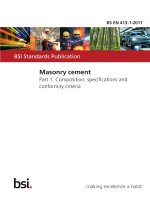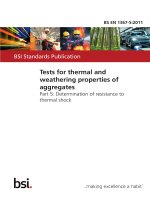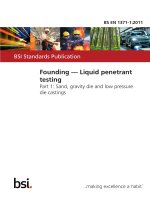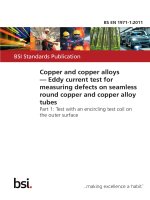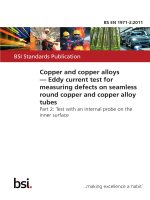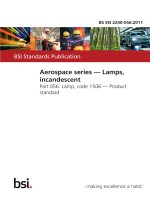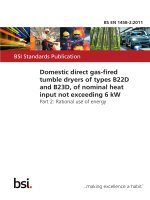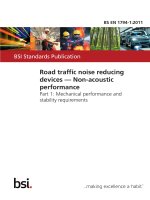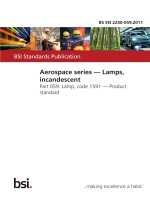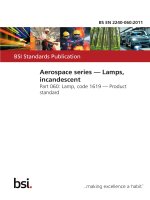Bsi bs en 62271 206 2011
Bạn đang xem bản rút gọn của tài liệu. Xem và tải ngay bản đầy đủ của tài liệu tại đây (1.16 MB, 28 trang )
BS EN 62271-206:2011
BSI Standards Publication
High-voltage switchgear
and controlgear
Part 206: Voltage presence indicating
systems for rated voltages above 1 kV
and up to and including 52 kV
BRITISH STANDARD
BS EN 62271-206:2011
National foreword
This British Standard is the UK implementation of EN 62271-206:2011.
It is identical to IEC 62271-206:2011. It supersedes BS EN 61958:2001,
which will be withdrawn on 3 March 2014.
The UK participation in its preparation was entrusted by Technical Committee
PEL/17, Switchgear, controlgear, and HV-LV co-ordination, to Subcommittee
PEL/17/1, High-voltage switchgear and controlgear.
A list of organizations represented on this committee can be obtained on
request to its secretary.
This publication does not purport to include all the necessary provisions of a
contract. Users are responsible for its correct application.
© BSI 2011
ISBN 978 0 580 68344 2
ICS 29.130.10
Compliance with a British Standard cannot confer immunity
from legal obligations.
This British Standard was published under the authority of the
Standards Policy and Strategy Committee on 31 July 2011.
Amendments issued since publication
Amd. No.
Date
Text affected
BS EN 62271-206:2011
EUROPEAN STANDARD
EN 62271-206
NORME EUROPÉENNE
March 2011
EUROPÄISCHE NORM
ICS 29.130.10
Supersedes EN 61958:2001
English version
High-voltage switchgear and controlgear Part 206: Voltage presence indicating systems for rated voltages above
1 kV and up to and including 52 kV
(IEC 62271-206:2011)
Appareillage à haute tension Partie 206: Systèmes indicateurs de
présence de tension assignées
supérieures à 1 kV et inférieures ou
égales à 52 kV
(CEI 62271-206:2011)
Hochspannungs-Schaltgeräte und Schaltanlagen Teil 206: Spannungsanzeigesysteme für
Bemessungsspannungen über 1 kV bis
einschließlich 52 kV
(IEC 62271-206:2011)
This European Standard was approved by CENELEC on 2011-03-03. CENELEC members are bound to comply
with the CEN/CENELEC Internal Regulations which stipulate the conditions for giving this European Standard
the status of a national standard without any alteration.
Up-to-date lists and bibliographical references concerning such national standards may be obtained on
application to the Central Secretariat or to any CENELEC member.
This European Standard exists in three official versions (English, French, German). A version in any other
language made by translation under the responsibility of a CENELEC member into its own language and notified
to the Central Secretariat has the same status as the official versions.
CENELEC members are the national electrotechnical committees of Austria, Belgium, Bulgaria, Croatia, Cyprus,
the Czech Republic, Denmark, Estonia, Finland, France, Germany, Greece, Hungary, Iceland, Ireland, Italy,
Latvia, Lithuania, Luxembourg, Malta, the Netherlands, Norway, Poland, Portugal, Romania, Slovakia, Slovenia,
Spain, Sweden, Switzerland and the United Kingdom.
CENELEC
European Committee for Electrotechnical Standardization
Comité Européen de Normalisation Electrotechnique
Europäisches Komitee für Elektrotechnische Normung
Management Centre: Avenue Marnix 17, B - 1000 Brussels
© 2011 CENELEC -
All rights of exploitation in any form and by any means reserved worldwide for CENELEC members.
Ref. No. EN 62271-206:2011 E
BS EN 62271-206:2011
EN 62271-206:2011
Foreword
The text of document 17C/491/FDIS, future edition 1 of IEC 62271-206, prepared by SC 17C,
High-voltage switchgear and controlgear assemblies, of IEC TC 17, Switchgear and controlgear, was
submitted to the IEC-CENELEC parallel vote and was approved by CENELEC as EN 62271-206 on
2011-03-03.
This European Standard supersedes EN 61958:2001.
The main changes with respect of EN 61958:2001 are an actualization of references and the degree of
protection which has been changed from IPXXB to IP2X.
Attention is drawn to the possibility that some of the elements of this document may be the subject of
patent rights. CEN and CENELEC shall not be held responsible for identifying any or all such patent
rights.
The following dates were fixed:
– latest date by which the EN has to be implemented
at national level by publication of an identical
national standard or by endorsement
(dop)
2011-12-03
– latest date by which the national standards conflicting
with the EN have to be withdrawn
(dow)
2014-03-03
Annex ZA has been added by CENELEC.
__________
Endorsement notice
The text of the International Standard IEC 62271-206:2011 was approved by CENELEC as a European
Standard without any modification.
__________
BS EN 62271-206:2011
EN 62271-206:2011
Annex ZA
(normative)
Normative references to international publications
with their corresponding European publications
The following referenced documents are indispensable for the application of this document. For dated
references, only the edition cited applies. For undated references, the latest edition of the referenced
document (including any amendments) applies.
NOTE When an international publication has been modified by common modifications, indicated by (mod), the relevant EN/HD
applies.
Publication
Year
Title
EN/HD
Year
IEC 60060-1
-
High-voltage test techniques Part 1: General definitions and test
requirements
EN 60060-1
-
IEC 60068-2-14
-
Environmental testing Part 2-14: Tests - Test N: Change of
temperature
EN 60068-2-14
-
IEC 60068-2-75
-
Environmental testing Part 2-75: Tests - Test Eh: Hammer tests
EN 60068-2-75
-
IEC 60529
-
Degrees of protection provided by enclosures (IP Code)
-
IEC 61243-1 (mod) -
EN 61243-1
Live working - Voltage detectors Part 1: Capacitive type to be used for voltages
exceeding 1 kV a.c.
-
IEC 61243-2 (mod) -
EN 61243-2
Live working - Voltage detectors Part 2: Resistive type to be used for voltages
of 1 kV to 36 kV a.c.
-
IEC 61243-5 (mod) -
Live working - Voltage detectors Part 5: Voltage detecting systems (VDS)
EN 61243-5
-
IEC 62271-1
2007
High-voltage switchgear and controlgear Part 1: Common specifications
EN 62271-1
2008
IEC 62271-200
-
High-voltage switchgear and controlgear EN 62271-200
Part 200: AC metal-enclosed switchgear and
controlgear for rated voltages above 1 kV and
up to and including 52 kV
-
IEC 62271-201
-
High-voltage switchgear and controlgear EN 62271-201
Part 201: AC insulation-enclosed switchgear + corr. November
and controlgear for rated voltages above 1 kV
and up to and including 52 kV
-
BS EN 62271-206:2011
62271-206 IEC:2011
CONTENTS
1
General . .......................................................................................................................................... 7
1.1
1.2
Scope . ................................................................................................................................... 7
Normative references . ........................................................................................................ 7
2
Service conditions. ......................................................................................................................... 7
3
Terms and definitions . .................................................................................................................. 8
4
Ratings . ........................................................................................................................................... 8
5
4.1 Rated voltage ....................................................................................................................... 9
4.2 Rated insulation level . ......................................................................................................... 9
4.3 Rated frequency . ................................................................................................................. 9
Design and construction . ............................................................................................................... 9
5.1
6
General ................................................................................................................................. 9
5.1.1 Parts of VPIS . ......................................................................................................... 9
5.1.2 Phase comparison . ................................................................................................ 9
5.1.3 Degree of protection (IP code) . ............................................................................ 9
5.1.4 Impact resistance . ................................................................................................. 9
5.1.5 Testing element ...................................................................................................... 9
5.2 Threshold values for voltage presence indication . .......................................................... 9
5.3 Indication and perceptibility . ............................................................................................. 10
5.3.1 General . ................................................................................................................ 10
5.3.2 Frequency of repetition . ...................................................................................... 10
5.3.3 Response time ...................................................................................................... 10
5.3.4 Indication until power source is exhausted........................................................ 10
5.4 Coupling element and voltage limiting device . .............................................................. 10
5.4.1 Insulation of coupling element . ........................................................................... 10
5.4.2 Voltage limiting device . ....................................................................................... 10
5.4.3 Threshold voltage of voltage limiting device. .................................................... 11
5.4.4 Earth fault conditions . ......................................................................................... 11
5.4.5 Maximum current delivered by the connecting point . ....................................... 11
5.5 Marking . ............................................................................................................................. 11
5.6 Phase comparator and connecting point . ....................................................................... 11
5.6.1 General . ................................................................................................................ 11
5.6.2 Clear indication of phase comparators . ............................................................ 12
5.6.3 Perceptibility of indication ................................................................................... 12
5.6.4 Indication in case of absence of voltage on one side ...................................... 12
5.6.5 Indication in case of absence of voltage on both sides . .................................. 12
5.7 Electromagnetic compatibility (EMC) . ............................................................................. 12
Type tests . .................................................................................................................................... 13
6.1
General . ............................................................................................................................. 13
6.1.1 Sequence of tests . ............................................................................................... 13
6.1.2 Test specimens . .................................................................................................. 13
6.1.3 Conditioning procedure . ...................................................................................... 13
6.1.4 Test voltages . ....................................................................................................... 13
6.1.5 Test conditions ..................................................................................................... 13
6.1.6 Values of currents and voltages . ....................................................................... 14
6.1.7 Tolerances............................................................................................................. 14
BS EN 62271-206:2011
62271-206 IEC:2011
6.2
Arrangement, assembly, marking, and instructions for use . ........................................ 14
6.3
6.4
6.5
6.6
6.7
7
Clear indication of VPIS . .................................................................................................. 14
Response time of VPIS ..................................................................................................... 14
Dielectric strength of the coupling element of VPIS . .................................................... 15
Maximum current delivered by the connecting point . .................................................... 15
Voltage limiting device ...................................................................................................... 15
6.7.1 General . ................................................................................................................ 15
6.7.2 Threshold voltage . ............................................................................................... 15
6.7.3 Current-carrying capacity .................................................................................... 15
6.8 Clear perceptibility of visual indication . ........................................................................... 16
6.8.1 Test voltages . ....................................................................................................... 16
6.8.2 Test set-up . .......................................................................................................... 16
6.8.3 Test procedure ..................................................................................................... 16
6.8.4 Test assessment . ................................................................................................ 16
6.8.5 Perceptibility of indication at maximum applied voltage . ................................. 16
6.8.6 Perceptibility of indication at low light level . ..................................................... 17
6.9 Impact resistance .............................................................................................................. 17
6.10 Clear indication of phase comparators ........................................................................... 17
6.10.1 Test set-up . .......................................................................................................... 17
6.10.2 Incorrect phase relationship . .............................................................................. 17
6.10.3 Correct phase relationship . ................................................................................ 17
6.10.4 Absence of voltage on one side .......................................................................... 17
6.10.5 Absence of voltage on both sides . ..................................................................... 18
6.11 Electromagnetic compatibility tests (EMC) . .................................................................... 18
6.12 Indication until power source is exhausted . ................................................................... 18
6.12.1 Test set-up . .......................................................................................................... 18
6.12.2 Determination of test voltage . ............................................................................. 18
6.12.3 Test procedure ..................................................................................................... 18
6.12.4 Repetition of test. ................................................................................................. 18
6.12.5 Multiple power sources . ...................................................................................... 18
6.12.6 Test assessment . ................................................................................................ 19
Routine tests ................................................................................................................................ 19
7.1
7.2
General . ............................................................................................................................. 19
Clear indication . ................................................................................................................. 19
8
Guide to the selection of VPIS . ................................................................................................. 19
9
Information to be given with enquiries, tenders and orders . .................................................. 19
10 Instructions for use . .................................................................................................................... 19
10.1 General ............................................................................................................................... 19
10.2 Instructions for use of VPIS ............................................................................................. 19
10.3 Instructions for use of phase comparators . .................................................................... 20
11 Safety . ........................................................................................................................................... 20
Bibliography ......................................................................................................................................... 24
Figure 1 – Voltage presence indicating system . ............................................................................. 21
Figure 2 – Examples for measuring the response time .................................................................. 22
Figure 3 – Test set-up for perceptibility of visual indication . ......................................................... 23
BS EN 62271-206:2011
62271-206 IEC:2011
Table 1 – Indication corresponding to "voltage present" . .............................................................. 10
Table 2 – Sequence of type tests for VPIS and phase comparators (PC) . .................................. 21
BS EN 62271-206:2011
62271-206 IEC:2011
–7–
HIGH-VOLTAGE SWITCHGEAR AND CONTROLGEAR –
Part 206: Voltage presence indicating systems for rated voltages
above 1 kV and up to and including 52 kV
1
1.1
General
Scope
This part of IEC 62271 is applicable to voltage presence indicating systems (VPIS) incorporated in a.c. switchgear and controlgear covered by IEC 62271-200 or IEC 62271-201.
Voltage presence indicating systems are devices used to provide information to operators
about the voltage condition of the main circuit of the switchgear in which they are installed.
The indication of VPIS alone is not sufficient to prove that the system is dead: if operating
procedures make it mandatory, relevant voltage detectors according to IEC 61243-1,
IEC 61243-2 and IEC 61243-5 should be used.
This standard is also applicable to phase comparators specifically designed for use with VPIS.
1.2
Normative references
The following referenced documents are indispensable for the application of this document. For
dated references, only the edition cited applies. For undated references, the latest edition of
the referenced document (including any amendments) applies.
IEC 60060-1, High-voltage test techniques – Part 1: General definitions and test requirements
IEC 60068-2-14, Environmental testing – Part 2-14: Tests – Test N: Change of temperature
IEC 60068-2-75, Environmental testing – Part 2-75: Tests – Test Eh: Hammer tests
IEC 60529, Degrees of protection provided by enclosures (IP code)
IEC 62271-1:2007, High-voltage switchgear and controlgear – Part 1: Common specifications
IEC 62271-200, High-voltage switchgear and controlgear – Part 200: AC metal-enclosed
switchgear and controlgear for rated voltages above 1 kV and up to and including 52 kV
IEC 62271-201, High-voltage switchgear and controlgear – Part 201: AC insulation-enclosed
switchgear and controlgear for rated voltages above 1 kV and up to and including 52 kV
IEC 61243-1, Live working – Voltage detectors – Part 1: Capacitive type to be used for
voltages exceeding 1 kV a.c.
IEC 61243-2, Live working – Voltage detectors – Part 2: Resistive type to be used for voltages
of 1 kV to 36 kV a.c.
IEC 61243-5, Live working – Voltage detectors – Part 5: Voltage detecting systems (VDS)
2
Service conditions
VPIS are designed to be used under the same service conditions as the switchgear in which
they are installed, as defined in Clause 2 of IEC 62271-1.
–8–
3
BS EN 62271-206:2011
62271-206 IEC:2011
Terms and definitions
For the purposes of this document, the following terms and definitions apply.
3.1
voltage presence indicating system (VPIS)
device used to indicate the presence of operating voltage
NOTE 1
VPIS may also be used in conjunction with phase comparators.
NOTE 2 VPIS are not designed to detect reliably the absence of voltage: for this purpose, only voltage detectors
or voltage detecting systems (VDS according to IEC 61243-5) should be used.
3.2
coupling element
part of the VPIS connected to the main circuit which transmits to the indicating element a
signal related to the voltage condition of this circuit. Different physical principles can be used
for the coupling element, for example, capacitive, resistive, optical, etc.
3.3
indicating element
part of the VPIS which gives a visual indication depending on the input signal received from the
coupling element
3.4
connecting point
point of the indicating element where a suitable phase comparator may be connected
3.5
phase comparator
apparatus which indicates the phase relationship between the connecting points of two VPIS
3.6
nominal voltage (U n )
suitable approximate value of voltage used to identify a system or device
[IEC 60050-601:1985, 601-01-21, modified]
NOTE 1 The nominal voltage of the VPIS is the parameter associated with its clear indication. VPIS may have one
nominal voltage U n , or a nominal voltage range. Limit values of the nominal voltage range are named U nmin and
U nmax.
NOTE 2 In this standard, the nominal voltage of a three-phase system is the normal phase-to-phase voltage. The
nominal voltage of a single-phase system is the normal voltage between lines.
3.7
voltage limiting device
protective device that limits the voltage at the output terminal of the coupling element in the
case of insulation failure
4
Ratings
The following ratings of the switchgear shall also be applicable to the VPIS incorporated in it:
–
rated voltage;
–
rated insulation level;
–
rated frequency(ies).
In addition, the nominal voltage, or nominal voltage range, of the systems on which the VPIS
can be used, shall be defined.
BS EN 62271-206:2011
62271-206 IEC:2011
4.1
–9–
Rated voltage
Refer to 4.1 of IEC 62271-1.
4.2
Rated insulation level
Refer to 4.2 of IEC 62271-1.
4.3
Rated frequency
Refer to 4.3 of IEC 62271-1.
5
Design and construction
5.1
General
5.1.1
Parts of VPIS
A VPIS includes
–
a coupling element;
–
an indicating element;
–
a connecting point (optional).
Both the coupling and indicating elements are fixed and incorporated in switchgear (see
Figure 1).
5.1.2
Phase comparison
VPIS should allow checking of phase relationship by means of a suitable phase comparator.
The characteristics of the phase comparator shall be defined by the manufacturer of the VPIS.
5.1.3
Degree of protection (IP code)
Parts of the VPIS which contribute to the switchgear enclosure shall meet the degree of
protection defined for the switchgear.
If the VPIS includes hazardous parts when in service, it shall provide at least an IP2X degree of
protection according to IEC 60529, even when replaceable parts are removed.
5.1.4
Impact resistance
Accessible parts of VPIS shall be resistant to mechanical impact.
5.1.5
Testing element
VPIS with a built-in power source shall be equipped with a testing element to check the
condition of the battery.
5.2
Threshold values for voltage presence indication
The threshold values for voltage presence indication are shown in the following Table 1.
– 10 –
BS EN 62271-206:2011
62271-206 IEC:2011
Table 1 – Indication corresponding to "voltage present"
The indication corresponding to "voltage present"
shall appear
shall not appear
in three-phase systems
when the actual line-to-earth voltage
is between 45 % of the nominal
voltage and the rated voltage
when the actual line-to-earth voltage
is less than 10 % of the nominal
voltage
in single-pole earthed single-phase
systems
when the actual line-to-earth voltage
is between 78 % of the nominal
voltage and the rated voltage
when the actual line-to-earth voltage
is less than 17 % of the nominal
voltage
in mid-point earthed single-phase
systems
when the actual line-to-earth voltage
is between 39 % of the nominal
voltage and 50 % of the rated voltage
when the actual line-to-earth voltage
is less than 9 % of the nominal
voltage
5.3
5.3.1
Indication and perceptibility
General
The indicating element of a VPIS shall provide a clear visual indication of the voltage state.
The indication shall be clearly perceptible to the user when in the recommended operating
position and under practical lighting conditions.
Some types of VPIS are restricted to indoor use, and others are suitable for indoor and outdoor
use.
5.3.2
Frequency of repetition
In the case of a repetitive visual indication, the frequency of repetition shall be at least 1 Hz.
This requirement shall be met for an actual line-to-earth voltage equal to, or greater than, 45 %
of the nominal voltage. For a line-to-earth voltage lower than 10 % of the nominal voltage, the
indication corresponding to "voltage not present" shall appear with no active signal allowed for
a VPIS having no built-in power source.
For single-phase systems, the applicable threshold values according to Table 1 shall be used.
5.3.3
Response time
The indicating element of a VPIS shall indicate the change of state of voltage within 1 s.
5.3.4
Indication until power source is exhausted
VPIS with a built-in power source shall give a clear indication of voltage presence until the
power source is exhausted, unless their usage is limited by an indication of non-readiness or
automatic shut-off.
5.4
5.4.1
Coupling element and voltage limiting device
Insulation of coupling element
The coupling element shall provide adequate insulation between its output terminal and the
main circuit.
5.4.2
Voltage limiting device
To provide protection for operators against the presence of operating voltage on the connecting
point, it shall be ensured that any insulation failure of the coupling element will necessarily
cause a permanent earth fault.
BS EN 62271-206:2011
62271-206 IEC:2011
– 11 –
This shall be achieved by connecting the coupling element output terminal to earth via a
voltage limiting device.
The voltage limiting device can be a specific component (for example, spark gap) or be one of
the components permanently connected to the coupling element (for example, an indicating
element component).
The effects caused by the response of the voltage limiting device shall be taken into account
when determining the protection concept of the installation.
5.4.3
Threshold voltage of voltage limiting device
The threshold voltage of the voltage limiting device shall comply with the following
requirements:
–
it shall be lower than 30 % of the nominal voltage of the power system;
–
it shall be less than the lowest limiting value of the dielectric strength in the remaining
components of the VPIS.
5.4.4
Earth fault conditions
For systems with insulated or resonant earthed neutral, earth fault currents are limited to low
values and the equipment can be maintained in operation for a long period of time under these
conditions.
In such cases, additional precautions shall be taken to ensure that either the earth fault
condition can easily be observed by operators, or no dangerous voltage can occur on the
connecting point for the earth fault duration.
5.4.5
Maximum current delivered by the connecting point
The current delivered by the connecting point when it is short-circuited to earth and with rated
frequency and rated voltage between conductor and earth shall not exceed 2 mA. If the degree
of protection of the connecting point is lower than IP2X, the current value shall be limited
to 0,5 mA.
5.5
Marking
Marking shall be legible and permanent. It may be printed, engraved or moulded on the VPIS
casing or switchgear front panel in the vicinity of the indicating element and connecting point.
The following markings, at least, shall be assigned to the indicating element and connecting
point in a perceptible manner with characters of at least 3 mm high:
–
IEC 62271-206;
–
nominal voltage(s) (or range of nominal voltages) of VPIS;
–
phase designation (L1, L2, L3).
As an alternative, the first two items may be added to the nameplate of the switchgear.
5.6
5.6.1
Phase comparator and connecting point
General
The manufacturer of VPIS shall state which types of phase comparators are suitable for use
with the VPIS.
– 12 –
5.6.2
BS EN 62271-206:2011
62271-206 IEC:2011
Clear indication of phase comparators
Phase comparators shall indicate "incorrect phase relationship" if the phase shift between lineto-earth voltages exceeds 30° and shall indicate "correct phase relationship" if the phase shift
is less than 10°.
Phase comparators used on VPIS shall comply with these requirements for line-to-earth
operating voltages in the range of U n / 3 ± 8 %.
The clear indication of a phase comparator shall not be affected by the difference between
signals delivered on connecting points which can result from
–
a difference of up to 5 % between operating voltages,
–
construction tolerances of identical VPIS.
NOTE Other threshold values for phase angles may be agreed between the manufacturer and the user according
to the intended application, for example:
–
if the purpose of phase comparison is to check that there are no interchanged connections before closing a
circuit, then the upper threshold value can be increased from 30° to, for example, 60° because the resulting
phase shift would be 120°;
–
in some specific situations, two different systems can be out of phase by exactly 30°; in that case, the upper
threshold value should be reduced from 30° to, for example, 25°.
5.6.3
Perceptibility of indication
Phase comparators shall indicate "incorrect phase relationship" by means of an active signal.
Phase comparators with a built-in power source shall indicate both "correct phase relationship"
and "incorrect phase relationship" by means of active signals. The two active signals shall not
rely solely on light of different colours for perceptibility. Additional characteristics, such as
spatial separation of the light sources, distinctive form of the light signals, flashing light or
audible signals with full sound pressure level, shall be used.
5.6.4
Indication in case of absence of voltage on one side
For phase comparators providing only one active signal, a voltage less than 10 % of U n on one
side and more than 45 % of U n on the other shall lead to the indication "incorrect phase
relationship". For phase comparators providing two or more active signals, absence of voltage
on one side shall result in either no indication or a specific active signal.
5.6.5
Indication in case of absence of voltage on both sides
Voltages of less than 10 % of U n on both sides shall lead to no indication.
5.7
Electromagnetic compatibility (EMC)
A VPIS is a part of the secondary system of switchgear as defined in 5.18 of IEC 62271-1.
Therefore, 5.18 and 6.9 of IEC 62271-1 shall be applicable to VPIS.
BS EN 62271-206:2011
62271-206 IEC:2011
6
– 13 –
Type tests
6.1
General
6.1.1
Sequence of tests
The tests for VPIS are given in Table 2. The tests shall be carried out in the sequence given in
this table. All tests shall be carried out on the same specimen, except for test of 6.7.3, which
may be performed separately.
Where the following test requirements do not allow tests on individual parts, the respective
tests shall be performed on complete devices.
Single-phase tests are normally sufficient. Three-phase tests are prescribed where needed.
6.1.2
Test specimens
Type tests shall be performed on three test specimens and/or three complete devices. If a test
specimen does not pass one of the type tests, the entire type test programme shall be
repeated on three more specimens. If a specimen again does not pass one type test, the
equipment has failed the test.
NOTE An individual type test need not be repeated for a change of construction detail, if the manufacturer can
demonstrate that this change does not influence the result of that individual type test.
6.1.3
Conditioning procedure
Prior to type tests, all test specimens shall be subjected, as a conditioning procedure, to a
change of temperature test Nb according to IEC 60068-2-14 with the following test parameters:
–
the lower temperature T A shall be equal to the minimum ambient air temperature specified
in the service conditions;
–
the higher temperature T B shall be 15 K over the maximum ambient air temperature
specified in the service conditions;
–
the rate of change of temperature shall be 0,5 °C/min;
–
the exposure duration t 1 shall be equal to 3 h;
–
two cycles shall be performed.
6.1.4
Test voltages
Voltage tests shall, if not otherwise specified below, be performed with alternating voltages at
rated frequency complying with the requirements of IEC 60060-1.
6.1.5
Test conditions
Unless otherwise specified in the individual test subclauses, the electrical tests shall be
performed under the following standard atmospheric conditions:
–
ambient temperature: 15 °C to 35 °C;
–
relative humidity: 45 % to 75 %;
–
atmospheric pressure: 86 kPa to 106 kPa.
For dielectric tests, atmospheric correction factors according to IEC 60060-1 shall be used
when applicable.
– 14 –
6.1.6
BS EN 62271-206:2011
62271-206 IEC:2011
Values of currents and voltages
All a.c. currents and voltages are defined as, and shall be expressed as, r.m.s. values.
6.1.7
Tolerances
For all values required, deviations of ±5 % are permissible, unless otherwise specified in
the individual test subclauses. For dielectric tests, tolerances on test voltages defined by
IEC 60060-1 are applicable.
6.2
Arrangement, assembly, marking, and instructions for use
It shall be verified whether the following requirements are fulfilled if applicable, either by visual
inspection, measuring or other method of checking:
–
arrangement according to 5.1.1;
–
characteristics of phase comparator according to 5.1.2;
–
degree of protection according to 5.1.3;
–
testing element according to 5.1.5;
–
type of VPIS according to 5.3.1;
–
protection concept according to 5.4.2;
–
marking according to 5.5;
–
indication of phase comparator according to 5.6.4 and 5.6.5;
–
instructions for use according to Clause 10.
6.3
Clear indication of VPIS
If VPIS are used in three-phase systems, the following test shall be performed on a threephase basis.
A three-phase voltage source shall be connected to the main circuit of the switchgear
containing the coupling element and its neutral point to the earthing connection of the
switchgear. No other equipment, for example, phase comparators or other measuring devices,
shall be connected to the connecting point.
The test voltage shall be increased until the indication "voltage present" appears. The applied
line-to-earth voltage U vp shall be recorded. The line-to-earth test voltage shall then be
increased up to the rated voltage (U r ).
The test is considered as passed if the voltage U vp is between 10 % of U nmax and 45 % of
U nmin in three-phase systems and if a clear indication "voltage present" is given in the voltage
range from U vp to U r .
Additionally, in the case of a repetitive indication, it shall be verified that the frequency of
repetition is equal to, or higher than, 1 Hz in the voltage range from 45 % of the nominal
voltage to U r .
NOTE For systems other than three-phase, the applicable phase-to-phase or phase-to-earth voltage should be
used to determine the upper limit for U vp , for example 78 % of the nominal voltage in single-pole earthed singlephase systems, 39 % of the nominal voltage in mid-point earthed single-phase systems.
6.4
Response time of VPIS
The VPIS shall be connected according to 6.3 to a line-to-earth voltage equal to 45 % of U n .
BS EN 62271-206:2011
62271-206 IEC:2011
– 15 –
The test voltage shall be switched on and off five times. The duration of the on and off periods
shall be varied and be at least 3 s long. The voltage conditions (on/off) of the voltage source
and the indications shall be recorded as a function of time (see Figure 2).
The response time t r , as defined in Figure 2, according to the type of indication shall be
determined from the records.
The test is considered as passed, if none of the measured response times is longer than 1 s.
6.5
Dielectric strength of the coupling element of VPIS
The lightning impulse voltage withstand test and the power-frequency voltage withstand test
defined in IEC 62271-1 shall be applied to the VPIS or to the switchgear including the VPIS.
The values of test voltage shall be those corresponding to the rated voltage of the VPIS or
switchgear according to IEC 62271-1.
The test voltage shall be applied to the main circuit and the VPIS shall be connected to earth
as in practice.
The tests shall be carried out and assessed in accordance with IEC 62271-1.
During the tests, operation of the voltage limiting device may occur. This shall not cause any
damage to the VPIS.
6.6
Maximum current delivered by the connecting point
A single-phase voltage source shall be connected between all main circuits of the switchgear
containing the VPIS and the earthing connection of the switchgear. The connecting point of
the VPIS shall be connected to earth via a current measuring device. The rated voltage of the
VPIS shall be applied as the test voltage.
The test is considered as passed, if the measured current does not exceed the value specified
in 5.4.5.
6.7
6.7.1
Voltage limiting device
General
The tests shall be performed on the complete VPIS.
6.7.2
Threshold voltage
The a.c. test voltage shall be applied to the output terminal of coupling element and steadily
increased until flashover, breakdown or voltage limitation occurs in the VPIS.
The test is considered as passed, when flashover, breakdown or limitation has occurred at the
voltage limiting device and the test voltage has been not more than 30 % of U nmin .
6.7.3
Current-carrying capacity
The current-carrying capacity of the voltage limiting device shall be proven by the following
test.
An a.c. voltage source shall be connected between the output terminal of the coupling element
and earth. The voltage shall be adjusted to U n / 3 , and the prospective current shall be set
at 50 A with a power factor less than 0,15 inductive.
– 16 –
BS EN 62271-206:2011
62271-206 IEC:2011
The following test sequence shall be performed:
–
current duration: 1 s;
–
pause 2: min;
–
current duration: 1 s.
The test is considered as passed if in the above test sequence the voltage limiting device
functions correctly and carries the current. During or after the test, the voltage limiting device
may be damaged. In such a case, the test according to 6.7.2 shall be repeated in order to
verify that voltage limitation is still effective.
Additionally, in the case of VPIS intended for use on systems with insulated or resonant
earthed neutral, it shall be verified that either earth fault condition is clearly observable, or the
voltage at connecting point does not exceed 50 V r.m.s. for the fault duration.
NOTE Other test conditions, for example a higher current or a different test sequence, may be chosen upon
agreement between the manufacturer and the user.
6.8
Clear perceptibility of visual indication
6.8.1
Test voltages
The VPIS shall be connected according to 6.3 to a line-to-earth voltage of 0,45 × U nmin , U nmin
being the minimum value of the nominal voltage range.
For a VPIS with a built-in power source, the voltage supply shall be set during indication at
5 % ± 1 % above the voltage at which the VPIS shuts off or gives an indication of nonreadiness. This voltage may be taken from another electrical energy source.
6.8.2
Test set-up
The indicating element shall be placed in front of the centre of an unpolished grey screen of at
least 1 000 mm in diameter with a reflectivity index of 18 % or mounted on the switchgear front
panel as in practice. The indicating element shall be illuminated with diffuse white light from
two light sources, which shall be at least 1 000 mm from it, as shown in Figure 3, so that the
illuminance on the test specimen is the following:
–
1 000 lx ± 10 % for VPIS assigned for indoor use;
–
25 000 lx ± 10 % for VPIS assigned for outdoor use.
At a distance of 750 mm from the indicating element, a perforated front plate according to
Figure 3 shall be arranged.
6.8.3
Test procedure
The test shall be performed by three observers, each with average eyesight, looking at the
indicating element through the holes in the front plate. The test voltage shall be switched on
and off several times at irregular time intervals not known to the observers.
6.8.4
Test assessment
The test is considered as passed, when each of the three observers has perceived all
indications without doubt or error through each hole.
6.8.5
Perceptibility of indication at maximum applied voltage
Indicating elements whose indicating characteristics depend on the applied test voltage shall
be tested again according to 6.8.1 to 6.8.4, with a test voltage of 1,2 × U nmax.
BS EN 62271-206:2011
62271-206 IEC:2011
6.8.6
– 17 –
Perceptibility of indication at low light level
On indicating elements with non-actively light-emitting indication, the test shall be repeated
according to 6.8.1, 6.8.3, 6.8.4 and 6.8.5 in the test assembly according to 6.8.2, but with an
illuminance of the accompanying light of 10 lx.
6.9
Impact resistance
The accessible part of the VPIS shall be subjected to an impact test according to IEC 60068-2-75.
The specified impact level is 1 J.
Three blows shall be applied to the points that are likely to be the weakest. The use of a
spring-operated hammer is recommended.
After the test, the specimen shall show no breaks, and any deformation shall not affect the
normal function or the degree of protection specified in 5.1.3. Superficial damage shall be
ignored.
6.10
6.10.1
Clear indication of phase comparators
Test set-up
The phase comparator shall be connected to the connecting points of two VPIS.
The primary line-to-earth voltages applied to each VPIS are respectively U 1 and U 2 .
6.10.2
Incorrect phase relationship
In the first test run, U 1 and U 2 shall be set at 0,92 × U nmin / 3 , U nmin being the minimum value
of the nominal voltage range. A phase difference of 30° shall be adjusted between U 1 and U 2 .
The test is considered as passed if the indication "incorrect phase relationship" appears.
NOTE
6.10.3
Different phase values may be considered, as stated in the note of 5.6.2.
Correct phase relationship
In the second test run, U 1 shall be set at 1,08 × U nmax / 3 , U nmax being the maximum value of
the nominal voltage range, and U 2 shall be set at 0,95 × U 1 . A phase difference of 10° shall be
adjusted between U 1 and U 2 .
The test is considered as passed if the indication "incorrect phase relationship" does not
appear. In the case of a phase comparator with two active signals, the indication "correct
phase relationship" shall appear.
6.10.4
Absence of voltage on one side
In the third test run, the terminal connected to U 1 shall be disconnected and earthed and U 2 set
to U nmax / 3 , U nmax being the maximum value of the nominal voltage range.
The test is considered as passed if the following conditions are fulfilled:
–
for phase comparators with only one signal, no indication of "correct phase relationship" is
permitted;
–
for phase comparators with two active signals, no indication is permitted;
– 18 –
–
BS EN 62271-206:2011
62271-206 IEC:2011
for phase comparators with a specific active signal, the indication shall be that the voltage
is less than 10 % of U n .
6.10.5
Absence of voltage on both sides
In the fourth test run, U 1 and U 2 shall be set at 0,07 × U nmax, U nmax being the maximum value
of the nominal voltage range. A phase difference of 120° shall be adjusted between U 1 and U 2 .
The test is considered as passed if no indication appears.
6.11
Electromagnetic compatibility tests (EMC)
If the VPIS includes electronic equipment or components, it shall be submitted to EMC tests
according to 6.9 of IEC 62271-1.
Test voltages shall be applied to the output terminal of the coupling element of the VPIS.
For assessment of tests according to 6.9.2.3 and 6.9.2.4 of IEC 62271-1, criterion B as defined
in 6.9.2.5, Table 16, of IEC 62271-1 shall be used.
6.12
Indication until power source is exhausted
This test shall be performed on a VPIS with a built-in power source.
6.12.1
Test set-up
A constantly controlled voltage source in series with a resistor which is approximately equal to
the internal resistance of the built-in power source at the end of its scheduled service life shall
be substituted for the built-in power source. The initial value of the voltage of the controlled
voltage source shall be set at the nominal voltage of the built-in power source.
6.12.2
Determination of test voltage
The threshold voltage U vp according to 6.3 shall be determined. For the following tests, the test
voltage shall be set at 10 % above U vp .
6.12.3
Test procedure
The test voltage shall be switched on. The voltage of the controlled voltage source shall be
measured and set at 5 % below the initial value. Then the test voltage shall be switched off.
The on-duration shall be at least 10 s. This test step shall be repeated, reducing the voltage of
the controlled voltage source in steps of 5 % of the initial value, until the VPIS shuts off or
gives an indication of non-readiness.
The indications shall be observed to verify that there is no ambiguity.
6.12.4
Repetition of test
The voltage of the controlled voltage source shall be reset to the initial value according
to 6.12.1, and the entire test according to 6.12.3 repeated twice.
6.12.5
Multiple power sources
For a VPIS having several power sources independent from each other, the test shall be
performed according to 6.12.1 to 6.12.4 on each of the power sources separately and then with
all of them together.
BS EN 62271-206:2011
62271-206 IEC:2011
6.12.6
– 19 –
Test assessment
The test is considered as passed if all indications are unambiguous.
7
Routine tests
7.1
General
The VPIS shall be installed in the switchgear or controlgear. Then the dielectric tests according
to 7.1 and 7.2 of IEC 62271-1 shall be applied to the complete switchgear or controlgear
including the VPIS.
7.2
Clear indication
A clear indication test according to 6.3 shall be carried out. If it has been demonstrated during
type testing that the indication of the VPIS is not severely affected by the voltage condition of
adjacent phases, then the routine test may be carried out as a single-phase test.
8
Guide to the selection of VPIS
It is the responsibility of the switchgear manufacturer to ensure that the VPIS is suitable for
the ratings and service conditions determined for the switchgear according to Clause 8 of
IEC 62271-200 or IEC 62271-201.
Additionally, it is necessary to consider
–
the nominal voltage of the system;
–
the type of system neutral earthing;
–
the type of VPIS (indoor or outdoor use).
9
Information to be given with enquiries, tenders and orders
Information regarding VPIS shall be included in general information to be supplied for
switchgear according to Clause 9 of IEC 62271-200 or IEC 62271-201.
Of particular interest for VPIS is information about
–
characteristics of the system on which the switchgear is to be used (nominal and highest
voltage, frequency, type of system neutral earthing);
–
ratings;
–
service conditions;
–
type of VPIS (indoor or outdoor use).
10 Instructions for use
10.1
General
VPIS and phase comparators shall be accompanied by the manufacturer's instructions for use.
These instructions may be included in the instructions for use for the switchgear in which
the VPIS is installed.
10.2
Instructions for use of VPIS
Instructions for use of VPIS shall include at least the following explanations and instructions:
– 20 –
BS EN 62271-206:2011
62271-206 IEC:2011
–
explanation of labels and markings;
–
explanation of indications;
–
statement that the clear indication "voltage present" is ensured in the voltage range
according to IEC 62271-206;
–
the following warning: "The indication of VPIS alone is not sufficient to prove that the
system is dead: if operating procedures make it mandatory, relevant voltage detectors
according to IEC 61243-1, IEC 61243-2 and IEC 61243-5 shall be used";
–
explanation of the purpose of the connecting points;
–
statement of the type of phase comparator suitable for use with the VPIS;
–
if applicable, statement of which parts of the indicating element can be replaced by the user
and their specifications (for example, type of battery for indicating elements with built-in
power source);
–
statement that it might be necessary under extra-bright illumination to improve the visible
perceptibility by additional means, for example, by shadowing the indication.
10.3
Instructions for use of phase comparators
Instructions for the use of phase comparators shall include at least the following explanations
and instructions:
–
explanation of use;
–
explanation of indications, including indication when built-in power source is exhausted,
when applicable;
–
statement on nominal frequency;
–
statement on which specific VPIS the phase comparator is applicable;
–
statement on the indication ranges of correct and incorrect phase relationship according to
IEC 62271-206; if applicable, statement on voltage difference or nominal frequency
deviation that is allowed before an erroneous indication of phase angle occurs;
–
statement on possible indications depending on situations (such as correct, incorrect phase
relationship, missing voltage(s));
–
statement concerning possible effects of interference voltages (harmonics);
–
elements with built-in power source: statement of the type of battery to be used;
–
statement on storage and care, for example, temperature range;
–
prescription of how to test the correct functioning of the comparator.
11 Safety
General recommendations of Clause 11 of IEC 62271-1 and IEC 61243-1, IEC 61243-2 and
IEC 61243-5 also apply to VPIS.
In this standard, safety aspects are covered by the requirements of 5.4.
BS EN 62271-206:2011
62271-206 IEC:2011
– 21 –
Table 2 – Sequence of type tests for VPIS and phase comparators (PC)
Order of test
Subclause
1
Test
6.2
Part to be tested
Requirements
Arrangement, assembly,
marking, and instructions
for use
VPIS
PC
5.1.1, 5.1.2, 5.1.3,
5.1.5, 5.3.1, 5.4.5,
5.5, 11.2
5.6.4, 5.6.5, 11.3
2
6.5
Dielectric strength of the
coupling element of VPIS
VPIS
5.4.1
3
6.6
Maximum current delivered VPIS
by the connecting point
5.4.5
4
6.7
Voltage limiting device
VPIS
5.4.2, 5.4.3, 5.4.4
5
6.9
Impact resistance
VPIS
5.1.4
6
6.11
EMC
VPIS
5.7
7
6.3
Clear indication of VPIS
VPIS
5.2, 5.3.2
8
6.4
Response time of VPIS
VPIS
5.3.3
9
6.8
Clear perceptibility of
visual indication
VPIS
5.3.1
10
6.12
Indication until power
source is exhausted
VPIS
5.3.4
11
6.10
Clear indication of phase
comparators
PC
5.6.2, 5.6.3, 5.6.4,
5.6.5
1
Key
b
a
4
2
1 main circuit
2 coupling element
3
3 indicating element
4 connecting point (optional)
a signal from coupling element
IEC 2225/2000
NOTE
b signal at connecting point
Connection to earth may be physically located on the indicating element.
Figure 1 – Voltage presence indicating system
BS EN 62271-206:2011
62271-206 IEC:2011
– 22 –
State
Test voltage
Example a
Signal for "Voltage not present"
Signal for "Voltage present"
Example b
Signal
Example c
Signal
Example d
Signal
Example e
Signal
t ....... time
t i ....... interval duration t p ...... pulse duration
Example
Number of
different signals
a
b
c
d
e
2
1
1
1
1
t r ...... response time
Signal for the indication
"voltage not present"
"voltage present"
Steady
Steady
Intermittent
None
None
Steady
Intermittent
Steady
Steady
Intermittent
Figure 2 – Examples for measuring the response time
BS EN 62271-206:2011
62271-206 IEC:2011
– 23 –
2 light sources
2 sources
lumineuses
Two
light sources
perforated
front
plate
Perforated
front
plate
plaque avant perforée
indicating element
élément indicateur
Indicating element
30°
30°
30°
30°
Light
screen
lightgrey
grey
screen
1surface
000 × 1 000
gris clair
1000x1000
750
750
IEC
2227/2000
3a – Top view
Figure 3a Figure
- Top view
/ Vue de dessus
3 mm thick opaque plate
plaque opaque de 3 mm
d'épaisseur
Opaque
plate 3 mm thick
plane of the light
sources and of the
indicating element
plan des
sources
Plane
of the
light
lumineuses
de
sources
and ofetthe
indicating
l'élémentelement
indicateur 400
400
55
44
33
1
1
22
6
6
7
7
7 holes dia 5 mm
7 trous
de 5dia
5 in
mm
Seven
holes
mm
diameter
100
100
400
400
600
600
dimensions in millimetres
IEC 2228/2000
dimensions en
millimètres
Dimensions in millimetres
Figure 3b – Front view of the front plate
Figure 3b - Front view of the front plate / Vue de face de la plaque avant
Figure 3 – Test set-up for perceptibility of visual indication
